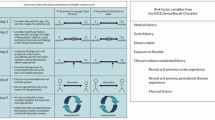Abstract
Data sources
Cochrane Central Register of Controlled Trials (CENTRAL), LILACS, Scopus, Web of Science, Medline and Embase.
Study selection
Human randomised controlled trials evaluating the effectiveness of reminders in orthodontics were included. Interventions including any form of participant reminder compared to a control. There were no limitations in terms of publication year, language or status. Primary outcomes measured were periodontal parameters and rate of attendance. Six secondary outcomes were also measured.
Data extraction and synthesis
Study selection and data extraction were carried out independently by two reviewers, with a third reviewer utilised to resolve disagreements. Authors were also contacted if any further clarification was required with regards to missing data. Risk of bias was assessed using the Cochrane tool. Comparable outcomes were collated and analysed using a random-effects model, with corresponding 95% confidence intervals.
Results
Fourteen parallel randomised controlled trials met the inclusion criteria. Only nine contributed to the meta-analyses, as five were deemed high risk of bias. Of the trials, ten RCTs, six RCTs, five RCTs and four RCTs measured plaque scores, gingival scores, rate of appointment attendance, and the effectiveness of reminder on the development of white spot lesions (WSLs) respectively. Results were grouped into either short term (1-3 months) or long term (>3 months) outcomes. In the short term, gingival condition was healthier in the reminders group (SMD = −0.66 with 95% CI: −0.97 – 0.35) and a statistically significant difference favouring patients receiving reminders was also seen in terms of plaque control (SMD = −0.38 with 95% CI: −0.65 to −0.10). In the long term, similar outcomes were recorded, with a statistically significant SMD for plaque scores and gingival scores when reminders were used (SMD −1.51 with 95% CI: −2.72 to −0.30 and SMD −1.94 with 95% CI: −3.81 to −0.07 respectively). Development of WSLs and risk of failure/cancellation were also lower in the reminder group.
Conclusions
This systematic review highlights that there is moderate to high quality evidence showing the positive effect of reminders on oral hygiene and appointment adherence in orthodontic patients. The authors suggest further high quality RCTs with longer follow-ups would be beneficial to support the efficacy of this intervention.
Similar content being viewed by others
Commentary
The aims of orthodontic treatment are to provide patients with a healthy, stable and aesthetically functional occlusion.1, 2 Both patients and orthodontic staff desire this outcome to be achieved within a predictable timeframe. However, when patients fail to maintain compliance with routine appointments and excellent oral hygiene, the result can be prolonged treatment, increased plaque levels, periodontal damage and white spot lesions (WSLs).3 Implementing a service which utilises active reminders has the potential to inform, encourage and reassure patients, thus reducing the number of failed appointments.
The uptake of National Health Service (NHS) orthodontic treatment in England has risen by 0.3% from 2016-2017 to 2017-2018.4 In light of this, and in view of the aforementioned undesirable side effects, the importance of attendance to recall appointments and adherence to oral hygiene measures is more important than ever.
This systematic review and meta-analysis aims to evaluate the effect of different forms of reminders on the oral hygiene of orthodontic patients, and to assess their impact on the rate of missed orthodontic appointments, total duration of treatment, and other commonly reported adverse effects.
A sound search strategy was adopted for this systematic review and meta-analysis. An electronic data search was completed without language or date limitation up to the 1 January 2018. Six electronic databases were searched (Cochrane Central Register of Controlled Trials (CENTRAL), LILACS, Scopus, Web of Science, Medline and Embase) and the authors also attempted to find ongoing and unpublished trials through manual searching of leading orthodontic journals. Strict inclusion and exclusion criteria were followed, which were derived using the PICO approach. Only randomised controlled trials for human patients currently enrolled or about to start any type of active orthodontic treatments were included.
The primary outcomes of periodontal parameter recording (plaque index, gingival index, bleeding index) and rate of attendance are relevant to the research question posed.
Further outcome measures (total duration of orthodontic treatment, development of white spot lesions, dental caries indices, brackets failure rates, patient reported outcomes and other adverse effects) were reported. Not all outcomes were addressed in all papers, but a simple table was included to allow for easy perusal and evaluation.
Two reviewers independently screened titles and abstracts against set criteria. Subsequent to this, two different reviewers independently performed data extraction, with a third reviewer resolving any highlighted disagreements. The reviewers also made a conscious effort to contact authors if additional clarification of their data was required. A flowchart allowed easy visualisation of the methodology used, number of studies identified and subsequently, those that were included in the review.
Methodological quality and risk of bias were assessed by the original two reviewers, and again disagreements were resolved by a third reviewer. The ‘Cochrane risk of bias tool’ was applied to categorise bias in individual studies as either low, presenting with some concerns, or high.
Data in relation to primary (periodontal) outcomes were grouped and statistically aggregated into two ‘clinically relevant’ time points: short term (1-3 months) and long term (>3 months). Interestingly, the average length of orthodontic treatment is approximately 20 months long.5 This poses the question as to whether these time points really do reflect ‘short term’ and ‘long term’ time points. Studies measured periodontal health using different indices and the authors have attempted to combat this by introducing a random effects model, with its corresponding 95% confidence interval. Heterogeneity between studies was evaluated using the I2 index.
After duplicates were removed, 327 studies were further evaluated and screened for suitability. Thirty-seven full texts were then assessed, twenty-three of which failed to meet the inclusion criteria. Fourteen parallel randomised control trials were therefore included, from nine different countries, making the total number of participants 2078. Of these 2078, 1054 received reminders (SMS, postal reminders, automated telephone calls and mobile applications) and 1024 did not receive reminders. Ten RCTs, six RCTs, five RCTs and four RCTs measured plaque scores, gingival scores, rate of appointment attendance and effectiveness of reminders on the development of WSLs respectively. A few tested the effect of reminders on gingival bleeding scores, caries development, debonding/failure of brackets and duration of treatment. Three RCTs were graded as low risk of bias, six were judged to have concerns with some domains and five were considered a high risk of bias. Although fourteen studies were included in qualitative synthesis, only nine contributed to the meta-analyses, as the high risk studies were omitted.
In the short term, plaque control (SMD = −0.38 with 95% CI: −0.65 to −0.10) and gingival scores (SMD = −0.66 with 95% CI: −0.97 to −0.35) favoured the intervention group, with a statistically significant difference compared to the control group (P = 0.008 and P = <0.0001 respectively), as shown by a Forest plot. Gingival bleeding was not statistically significant in the short term (P > 0.05), however, only one eligible study looked at this outcome.
In the long term, plaque control (SMD = −1.51 with 95% CI: −2.72 to −0.30), gingival scores (SMD = −1.94 with 95% CI: −3.81 to −0.07) and gingival bleeding favoured the intervention group, with a statistically significant difference from the control group (P=0.01, P=0.04 and P = <0.001 respectively).
With regards to the secondary outcomes, participants receiving reminders were less likely to develop WSLs (RR = 0.45 with 95% CI 0.31-0.65), less likely to cancel appointments (RR = 0.39 with 95% CI 0.22-0.70), and had less bracket failure rates (11.8% versus 16.1% for control) compared to controls with statistical significance (P= <0.0001, P = 0.002, P = <0.001 respectively). Single studies favouring the reminders group looked at treatment duration and orthodontic bracket failure rate. There was no difference in development of new carious lesions between groups, and none of the RCTs reported on patient-reported outcome measures.
This systematic review and meta-analysis appears to emphasise the benefit of reminder services on improvement in oral hygiene and adherence to orthodontic appointments. The authors state that there is moderate to high quality evidence to support this, however, they do highlight the importance of performing future additional high quality RCTs with longer follow-up periods.
In view of only two studies lasting longer than 12 months in duration, the true influence of reminder services on the primary and secondary outcomes are difficult to fully evaluate.
The authors do not discuss utilisation of reminder services at present, and one barrier to their introduction could be cost of implementation.
Interestingly, the authors did not specify removable appliance treatment as an exclusion criteria explicitly. This could have greatly influenced the outcomes with the potential of removable appliances having shorter treatment duration and ease of performing oral hygiene. Similar studies however, including Lima et al.6 support the outcomes of this study, suggesting reminder services are a valuable strategy in reduction of adverse side effects during orthodontic treatment (reduction in plaque and gingival scores, and lower WSL occurrence).3
Practice point
-
Provision of reminder services during orthodontic treatment has the potential to reduce the number of missed appointments
-
Patients who receive active reminders during their orthodontic treatment demonstrated better oral hygiene, lower risk of WSL development and overall better compliance with treatment.
References
Gosney MB . An investigation into some of the factors influencing the desire for orthodontic treatment. Br J Orthod 1986; 13: 87–94.
Aubrey RB . Occlusal objectives in orthodontic treatment. Am J Orthod 1978; 74: 162–175.
Ellis PE, Benson PE . Potential hazards of orthodontic treatment--what your patient should know. Dent Update 2002; 29: 492–496.
Primary Care Domain (30th August 2018) NHS Dental Statistics, England: 2017-18, NHS Digital, accessed at https://files.digital.nhs.uk/4F/B3B6FE/nhs-dent-stat-eng-17-18-rep.pdf (accessed December 2018)
Tsichlaki A, Chin SY, Pandis N, Fleming PS . How long does treatment with fixed orthodontic appliances last? A systematic review. Am J Orthod Dentofacial Orthop 2016; 149: 308–318. doi: 10.1016/j.ajodo.2015.09.020. Review. PubMed PMID: 26926017.
Lima IFP, de Andrade Vieira W, de Macedo Bernardino Í, et al. Influence of reminder therapy for controlling bacterial plaque in patients undergoing orthodontic treatment: A systematic review and meta-analysis. Angle Orthod 2018; 88: 483–493.
Author information
Authors and Affiliations
Additional information
Address for correspondence: Hisham Mohammed, Edinburgh Dental Institute, Lauriston Building, Lauriston Pl, Edinburgh EH3 9HA, UK. E-mail: Hishamyasser@hotmail.com
Mohammed H, Rizk MZ, Wafaie K, Ulhaq A, Almuzian M. Reminders improve oral hygiene and adherence to appointments in orthodontic patients: a systematic review and meta-analysis. Eur J Orthod 2018; doi:10.1093/ejo/cjy045
Rights and permissions
About this article
Cite this article
Jones, G., Goldsmith, R. & O'Donnell, K. Reminder systems during orthodontic treatment. Evid Based Dent 19, 109–110 (2018). https://doi.org/10.1038/sj.ebd.6401342
Published:
Issue Date:
DOI: https://doi.org/10.1038/sj.ebd.6401342
This article is cited by
-
Automated Emails to Improve Evening Staffing for Anesthesiologists
Journal of Medical Systems (2023)



